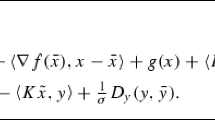Abstract
In the absence of strict complementarity, Monteiro and Wright [7] proved that the convergence rate for a class of Newton interior-point methods for linear complementarity problems is at best linear. They also established an upper bound of 1/4 for the Q 1-factor of the duality gap sequence when the steplengths converge to one. In the current paper, we prove that the Q 1 factor of the duality gap sequence is exactly 1/4. In addition, the convergence of the Tapia indicators is also discussed.
Similar content being viewed by others
References
A.S. El-Bakry, “On the role of indicators in identifying zero variables in linear programming,” Ph.D. Thesis, Department of Mathematical Sciences, Rice University, Houston, Texas 77251, 1991.
A.S. El-Bakry, R.A. Tapia, and Y. Zhang, “A study of indicators for identifying zero variables in interior-po methods,” SIAM Review, vol. 36, pp. 45–72, 1994.
A.J. Goldman and A.W. Tucker, “Theory of linear programming,” in H.W. Kuhn and A.W. Tucker (Eds.), Linear Inequalities and Related Systems, Princeton University Press, 1956, pp. 53–97.
O. Güler and Y. Ye, “Convergence behavior of some interior-point algorithms,” Math. Programming, Series A, vol. 60, pp. 215–228, 1993.
W. Hock and K. Schittkowski, Test Examples for Nonlinear Programming Codes, Springer-Verlag, New York, 1981.
S. Mizuno, “A superlinearly convergent infeasible interior-point algorithm for geometric LCPs without a strictly complementary solution,” Technical Report 878, School of Operations Research and Industrial Engineering, Cornell University, 1994.
R.C. Monteiro and S. Wright, “Local convergence of interior-point algorithms for degenerate monotone LCP problems,” Computational Optimization and Applications, vol. 3, pp. 131–155, 1994.
J.M. Ortega and W.C. Rheinboldt, Iterative Solution of Nonlinear Equations in Several Variables, Academic Press, New York, 1970.
F.A. Potra and R. Sheng, “A superlinearly convergent infeasible interior-point algorithm for degenerate LCP,” Technical Report 66, Department of Mathematics, Iowa University, Iowa 52242, 1995.
Y. Zhang, R.A. Tapia, and J.E. Dennis, “On the superlinear and quadratic convergence of primal-dual interiorpoint linear programming algorithms,” SIAM J. on Optimization, vol. 2, pp. 304–324, 1992.
Author information
Authors and Affiliations
Additional information
This author was supported in part by NSF Coop. Agr. No. CCR-8809615 and AFOSR 89-0363 and the REDI Foundation.
This author was supported in part by NSF Coop. Agr. No. CCR-8809615, AFOSR 89-0363, DOE DEFG05-86ER25017 and ARO 9DAAL03-90-G-0093.
Visiting member of the Center for Research on Parallel Computations, Rice University, Houston, Texas, 77251-1892. This author was supported in part by DOE DE-FG02-93ER25171.
Rights and permissions
About this article
Cite this article
El-Bakry, A.S., Tapia, R.A. & Zhang, Y. On the convergence rate of Newton interior-point methods in the absence of strict complementarity. Comput Optim Applic 6, 157–167 (1996). https://doi.org/10.1007/BF00249644
Issue Date:
DOI: https://doi.org/10.1007/BF00249644




